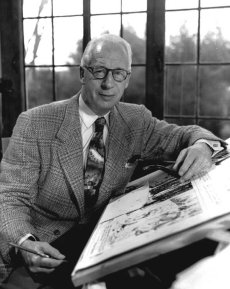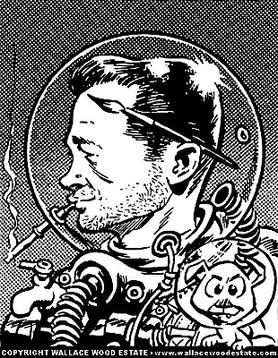
Prince Valiant in the Days of King Arthur, often simply called Prince Valiant, is an American comic strip created by Hal Foster in 1937. It is an epic adventure that has told a continuous story during its entire history, and the full stretch of that story now totals more than 4000 Sunday strips. The strip appears weekly in more than 300 American newspapers, according to its distributor, King Features Syndicate.

Harold Rudolf Foster, FRSA was a Canadian-American comic strip artist and writer best known as the creator of the comic strip Prince Valiant. His drawing style is noted for its high level of draftsmanship and attention to detail.

Wallace Allan Wood was an American comic book writer, artist and independent publisher, widely known for his work on EC Comics's titles such as Weird Science, Weird Fantasy, and MAD Magazine from its inception in 1952 until 1964, as well as for T.H.U.N.D.E.R. Agents, and work for Warren Publishing's Creepy. He drew a few early issues of Marvel's Daredevil and established the title character's distinctive red costume. Wood created and owned the long-running characters Sally Forth and Cannon.

John Cullen Murphy was an American illustrator best known for his three decades of work on the Prince Valiant comic strip.

King Features Syndicate, Inc. is an American content distribution and animation studio, consumer product licensing and print syndication company owned by Hearst Communications that distributes about 150 comic strips, newspaper columns, editorial cartoons, puzzles, and games to nearly 5,000 newspapers worldwide. King Features Syndicate also produces intellectual properties, develops new content and franchises, like The Cuphead Show!, which it produced with Netflix, and licenses its classic characters and properties.
United Feature Syndicate, Inc. (UFS) is a large American editorial column and comic strip newspaper syndication service based in the United States and established in 1919. Originally part of E. W. Scripps Company, it was part of United Media from 1978 to 2011, and is now a division of Andrews McMeel Syndication. United Features has syndicated many notable comic strips, including Peanuts, Garfield, Li'l Abner, Dilbert, Nancy, and Marmaduke.

The Sunday comics or Sunday strip is the comic strip section carried in most western newspapers. Compared to weekday comics, Sunday comics tend to be full pages and are in color. Many newspaper readers called this section the Sunday funnies, the funny papers or simply the funnies.

Elliot Caplin was an American comic strip writer best known as the co-creator of The Heart of Juliet Jones. His name is sometimes spelled with one extra letter: Elliott A. Caplin. He was the younger brother of Al Capp, creator of Li'l Abner.

Bob Oksner was an American comics artist known for both adventure comic strips and for superhero and humor comic books, primarily at DC Comics.
Broom-Hilda is an American newspaper comic strip created by cartoonist Russell Myers. Distributed by Tribune Content Agency, it depicts the misadventures of a man-crazy, cigar-smoking, beer-guzzling, 1,500-year-old witch and her motley crew of friends.

The Heart of Juliet Jones is an American comic strip series created by Elliott Caplin and drawn by Stan Drake, beginning on March 9, 1953. The strip was distributed by King Features Syndicate.
Sam and Silo is an American comic strip created by Mort Walker and Jerry Dumas, which began on April 18, 1977. The series is a "continuation" or a spin-off of Sam's Strip (1961-1963), as it uses the same characters. Dumas was solely responsible for the strip from 1995 and drew it until his death in 2016.

Agatha Crumm is a newspaper comic strip created by the cartoonist Bill Hoest and distributed by King Features Syndicate. The strip ran from October 24, 1977, until 1997. Agatha Crumm was Hoest's third strip, following Bumper Snickers (1974).

Jack Mendelsohn was an American writer-artist who worked in animation, comic strips and comic books. An Emmy-nominated television comedy writer and story editor, he had numerous credits as a TV scripter, including Rowan & Martin's Laugh-In, Three's Company, The Carol Burnett Show and Teenage Mutant Ninja Turtles. Among his work for feature films, he was a co-screenwriter of Yellow Submarine (1968). In 2004, the Animation Writers Caucus of the Writers Guild gave him a Lifetime Achievement Award.
Robert Bartow Lubbers was an American comic strip and comic book artist best known for his work on such strips as Tarzan, Li'l Abner and Long Sam.

Philip Eustice Blaisdell, better known as Tex Blaisdell, was an American comic-strip artist and comic-book editor. He worked on 22 syndicated features, including Little Orphan Annie, which he drew for five years.
The Register and Tribune Syndicate was a syndication service based in Des Moines, Iowa, that operated from 1922 to 1986, when it was acquired by King Features to become the Cowles Syndicate affiliate. At its peak, the Register and Tribune Syndicate offered newspapers some 60 to 75 features, including editorial cartoonist Herblock, comic strips, and commentaries by David Horowitz, Stanley Karnow, and others.

DailyINK was an online service created by King Features Syndicate to email many classic and current comic strips directly to subscribers for an annual fee of $19.99. King Features described it as "the all-inclusive subscription service for the true comics fan." On a web site and via email, the DailyINK service made available more than 90 vintage and current comic strips, panels, games, puzzles and editorial cartoons.

Andrea Bresciani was an Italian-born comics artist, illustrator, and animator. Of Slovenian origin, he was born Dušan Brešan in Tolmino and emigrated to Australia in 1950. Amongst his works were the Italian comic book series Geky Dor and Tony Falco and the widely syndicated Australian series Frontiers of Science. In the latter part of his career he worked as a film and television animator for Hanna-Barbera and Marvel Productions. Bresciani died in Malvern, Australia at the age of 83.
The Frank Jay Markey Syndicate was a small print syndication service that distributed comic strips and columns from the mid-1930s to c. 1950. Although small in size, the syndicate distributed strips by a number of notable cartoonists, including Ed Wheelan, Rube Goldberg, Boody Rogers, and Frank Borth. The syndicate also provided material for the burgeoning comic book industry, for companies like Quality Comics and Columbia Comics.















